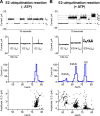Label-Free and Real-Time Detection of Protein Ubiquitination with a Biological Nanopore
- PMID: 28353339
- PMCID: PMC5444049
- DOI: 10.1021/acsnano.6b07760
Label-Free and Real-Time Detection of Protein Ubiquitination with a Biological Nanopore
Abstract
The covalent addition of ubiquitin to target proteins is a key post-translational modification that is linked to a myriad of biological processes. Here, we report a fast, single-molecule, and label-free method to probe the ubiquitination of proteins employing an engineered Cytolysin A (ClyA) nanopore. We show that ionic currents can be used to recognize mono- and polyubiquitinated forms of native proteins under physiological conditions. Using defined conjugates, we also show that isomeric monoubiquitinated proteins can be discriminated. The nanopore approach allows following the ubiquitination reaction in real time, which will accelerate the understanding of fundamental mechanisms linked to protein ubiquitination.
Keywords: nanopore; nanotechnology; protein modifications; single-molecule kinetics; ubiquitin.
Conflict of interest statement
The authors declare no competing financial interest.
Figures





Similar articles
-
Preparation of Cytolysin A (ClyA) Nanopores.Methods Mol Biol. 2021;2186:11-18. doi: 10.1007/978-1-0716-0806-7_2. Methods Mol Biol. 2021. PMID: 32918726
-
Direct Sensing and Discrimination among Ubiquitin and Ubiquitin Chains Using Solid-State Nanopores.Biophys J. 2015 May 5;108(9):2340-9. doi: 10.1016/j.bpj.2015.03.025. Biophys J. 2015. PMID: 25954891 Free PMC article.
-
Protein Motion and Configurations in a Form-Fitting Nanopore: Avidin in ClyA.Biophys J. 2018 Sep 4;115(5):801-808. doi: 10.1016/j.bpj.2018.07.024. Epub 2018 Aug 4. Biophys J. 2018. PMID: 30122294 Free PMC article.
-
Protein ubiquitination: a regulatory post-translational modification.Anticancer Drug Des. 1987 Oct;2(2):211-29. Anticancer Drug Des. 1987. PMID: 2835061 Review.
-
Visualizing ubiquitination in mammalian cells.EMBO Rep. 2019 Feb;20(2):e46520. doi: 10.15252/embr.201846520. Epub 2019 Jan 21. EMBO Rep. 2019. PMID: 30665942 Free PMC article. Review.
Cited by
-
Functionalised nanopores: chemical and biological modifications.Chem Sci. 2021 Dec 22;13(7):1869-1882. doi: 10.1039/d1sc05766a. eCollection 2022 Feb 16. Chem Sci. 2021. PMID: 35308845 Free PMC article. Review.
-
Covalent Modification of Silicon Nitride Nanopore by Amphoteric Polylysine for Short DNA Detection.ACS Omega. 2017 Oct 25;2(10):7127-7135. doi: 10.1021/acsomega.7b01245. eCollection 2017 Oct 31. ACS Omega. 2017. PMID: 31457292 Free PMC article.
-
PlyAB Nanopores Detect Single Amino Acid Differences in Folded Haemoglobin from Blood.Angew Chem Int Ed Engl. 2022 Aug 22;61(34):e202206227. doi: 10.1002/anie.202206227. Epub 2022 Jul 13. Angew Chem Int Ed Engl. 2022. PMID: 35759385 Free PMC article.
-
Quantification of Protein Glycosylation Using Nanopores.Nano Lett. 2022 Jul 13;22(13):5357-5364. doi: 10.1021/acs.nanolett.2c01338. Epub 2022 Jun 29. Nano Lett. 2022. PMID: 35766994 Free PMC article.
-
DNA barcodes using a double nanopore system.Sci Rep. 2021 May 7;11(1):9799. doi: 10.1038/s41598-021-89017-6. Sci Rep. 2021. PMID: 33963199 Free PMC article.
References
-
- Hershko A.; Heller H.; Elias S.; Ciechanover A. Components of Ubiquitin-Protein Ligase System. Resolution, Affinity Purification, and Role in Protein Breakdown. J. Biol. Chem. 1983, 258, 8206–8214. - PubMed
Publication types
MeSH terms
Substances
LinkOut - more resources
Full Text Sources
Other Literature Sources

